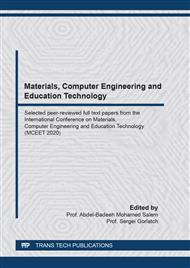p.184
p.194
p.202
p.211
p.221
p.231
p.241
p.249
p.263
Research on Electric Field Simulation of Ring Capacitance Sensor Based on Finite Element Method
Abstract:
The working principle of ring capacitance sensor is introduced, that is capacitance fringe effect. Finite element model is established through the Hybrid-Trefftz algorithm. Electric field analysis and simulation calculation of different sensor model are done with the finite element software ANSYS, and the optimal structure combination is obtained. And followed the example of optimal structure, the relation of dielectric constant and electric field intensity were given. The result of simulation shows the most direct and the most important two parameters that affect the sensor performance in the design of the ring capacitance sensor are the two electrodes spacing and the length. The dielectric constant of measured medium is smaller, the intensity of electric field intensity is greater. The simulation for subsequent product design has a good theoretical guidance.
Info:
Periodical:
Pages:
221-227
Citation:
Online since:
April 2021
Authors:
Keywords:
Price:
Сopyright:
© 2021 Trans Tech Publications Ltd. All Rights Reserved
Share:
Citation:


